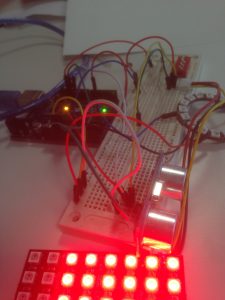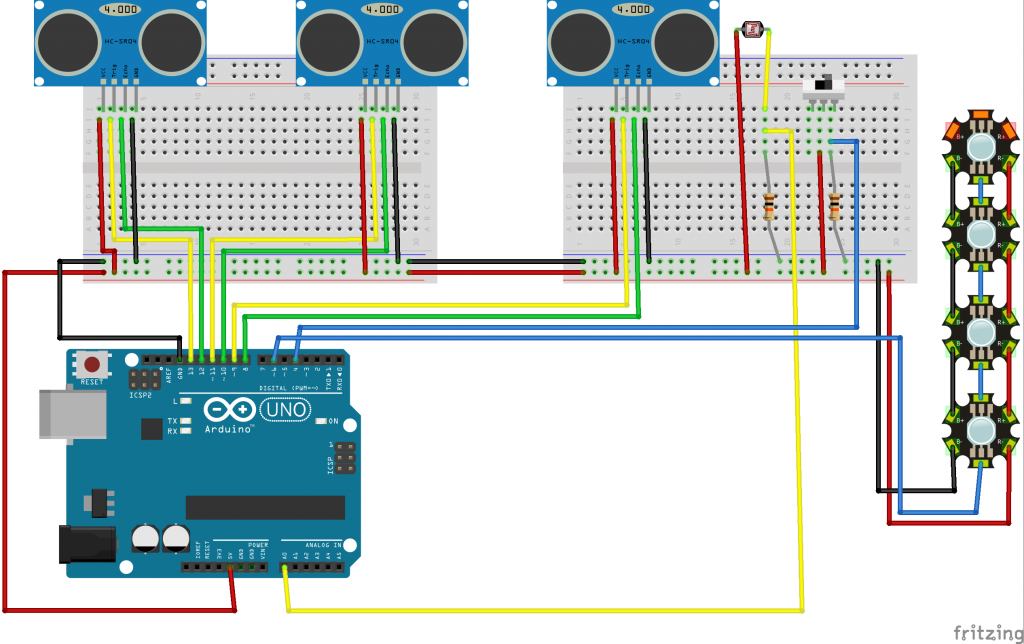Description of the project:
This project is a part of the intersemester course « FabLab » as a collaboration of IMT and l’Ecole Européenne Supérieure d’Arts de Bretagne. The theme of all the projects is « Light of Centre vie », which main idea is to find a way to improve the illumination of Centre vie in IMT Brest. We worked in a groups of 4 (Carlos Espinel – IMT, Damian Janikowski – IMT, Jung Yeon Shin – EESAB, Ulysse Sekpon – EESAB). Our project consider a specific area of Centre vie, we decided to work in the area where the piano is placed . We have chosen to create a lamp in shape of plant with several leaves. The whole thing will be powered by arduino.
Materials:
Electronic materials:
-Arduino
-Adafruit lights (LED RGB)
-Proximity sensor (HC-SR04)
-Photoresistor (light sensor)
-Resistors
-Switch
-Power supply
Construction material:
-Tracing paper
-Wood
The final version of the project is going to look like a branch with about 10 leaves. It’s going to be attached to frame on the pole that imitates a tree in a pot. Each leaf will be made of a plywood on which will be applied layer of a tracing paper for better light scattering.
Principle of work:
Each leave will have set of 4-6 LEDs which can light up the leaves with various colors. System will be equipped with proximity sensors that will detect presence of a person (distance smaller than certain threshold) and if it does – the light will change color. Furthermore the system will be equipped in the photoresistors that will be used as light sensors. When the brightness of the room is high the light will be turned off (or barely visible), but when it gets darker the lights will increase their power (close to maximum). Apart from that mode there will be one more that can be enabled with a switch. It will turn on persistent bright light for more practical purposes
Electronics:
Whole system is powered by arduino, which gathers and processes the data from the sensors. After that it will light up the LEDs in previously determined pattern.
In prototype (as well as it is planned for final version) the single LEDs are connected in chain as it is shown on the schematic of prototype. In final version the chain will contain about 40 LEDs.
Final bilan of materials:
- Arduino
- USB type B Cable
- 30 single LEDs (NeoPixel #1612)
- 3 proximity sensors (HC-SR04)
- photoresistor
- bistable switch
- 2 resistors (>100kOhm and 10<x<100kOhm)
- wires
Code final
#include <Adafruit_NeoPixel.h> // Proximity sensor #1 #define trigPin1 13 #define echoPin1 12 // Proximity sensor #2 #define trigPin2 9 #define echoPin2 11 // Proximity sensor #3 #define trigPin3 8 #define echoPin3 10 // light section #1 #define PIN 6 #define NUMPIXELS 30 // button #define button 4 // lightsensor int lightPin = 0; //define a pin for Photo resistor float light_mapped; long distance, distance1, distance2, distance3, duration; // variables for proximity sensors long distance1_c = 0; long distance2_c = 0; long distance3_c = 0; // filter for proximity sensors bool a1 = false; bool b1 = false; bool c1 = false; bool a2 = false; bool b2 = false; bool c2 = false; bool a3 = false; bool b3 = false; bool c3 = false; bool total = false; long true1 = 999.99; long true2 = 999.99; long true3 = 999.99; void SonarSensor(int trigPin, int echoPin); void ColorChange(int speed_of_change); void ModeOn(); void ModeOff(); // Colors struct RGB { float r; float g; float b; }; float temp_r, temp_g, temp_b; RGB temp = {0, 0, 0}; RGB old_color = {0, 0, 0}; RGB new_color = {0, 0, 0}; RGB green = {0, 255, 0}; RGB light_green = {120, 255, 0}; RGB yellow = { 255, 255, 0}; RGB orange = {255, 150, 0}; RGB brown = {155, 84, 0}; RGB beige = {255, 230, 140}; RGB white = {255, 255, 255}; RGB red = {255, 0, 0}; Adafruit_NeoPixel pixels = Adafruit_NeoPixel(NUMPIXELS, PIN, NEO_GRB + NEO_KHZ800); void setup() { Serial.begin (9600); // setup proximity sensor #1 pinMode(trigPin1, OUTPUT); pinMode(trigPin2, OUTPUT); pinMode(trigPin3, OUTPUT); pinMode(echoPin1, INPUT); pinMode(echoPin2, INPUT); pinMode(echoPin3, INPUT); pinMode(button, INPUT); pixels.begin(); temp = yellow; light_mapped = 100; ColorChange(2); delay(150); ColorChange(2); delay(150); ColorChange(2); delay(150); } long old_distance1 = 0; void loop() { if (digitalRead(button)) { Serial.println("ON"); if (!total) { ModeOn(); total = true; } } else { if (total) { ModeOff(); total = false; } Serial.println("OFF"); //read light sensor int light = analogRead(lightPin); light_mapped = map(light, 400, 960, 100, 0); if (light_mapped < 3) light_mapped = 3; Serial.print("Real light: "); Serial.print(light); //Write the value of the photoresistor to the serial monitor. Serial.print(" Mapped light: "); Serial.print(light_mapped); SonarSensor(trigPin1, echoPin1); distance1 = distance; SonarSensor(trigPin2, echoPin2); distance2 = distance; SonarSensor(trigPin3, echoPin3); distance3 = distance; // Distance measurement Serial.print(" #1: "); if (distance1 >= 200 || distance1 <= 0) { distance1 = 999.99; Serial.print("Out of range"); } else Serial.print(distance1); Serial.print(" #2: "); if (distance2 >= 200 || distance2 <= 0) { distance2 = 999.99; Serial.print("Out of range"); } else Serial.print(distance2); Serial.print(" #3: "); if (distance3 >= 200 || distance3 <= 0) { distance3 = 999.99; Serial.print("Out of range"); } else Serial.print(distance3); int threshold = 40; if ((distance1 > distance1_c - 20) && (distance1 < distance1_c + 20) && (distance1 < threshold)) { a1 = true; } else a1 = false; if (distance2 > distance2_c - 20 && distance2 < distance2_c + 20 && (distance2 < threshold)) { a2 = true; } else a2 = false; if (distance3 > distance3_c - 20 && distance3 < distance3_c + 20 && (distance3 < threshold)) { a3 = true; } else a3 = false; // first sensor if (a1 && b1 && c1) { ColorChange(2); a1 = false; b1 = false; c1 = false; } c1 = b1; b1 = a1; //second if (a2 && b2 && c2) { ColorChange(2); a2 = false; b2 = false; c2 = false; } c2 = b2; b2 = a2; //third if (a3 && b3 && c3) { ColorChange(2); a3 = false; b3 = false; c3 = false; } c3 = b3; b3 = a3; // remembering last measurement distance1_c = distance1; distance2_c = distance2; distance3_c = distance3; int i = 0; for (i; i < NUMPIXELS; i++) { pixels.setPixelColor(i, pixels.Color(temp.r * (light_mapped / 100), temp.g * (light_mapped / 100), temp.b * (light_mapped / 100))); // Moderately bright green color. pixels.show(); // This sends the updated pixel color to the hardware. } old_distance1 = distance1; delay(50); Serial.println(); } } void SonarSensor(int trigPin, int echoPin) { digitalWrite(trigPin, LOW); delayMicroseconds(2); digitalWrite(trigPin, HIGH); delayMicroseconds(10); digitalWrite(trigPin, LOW); duration = pulseIn(echoPin, HIGH); distance = (duration / 2) / 29.1; } void ColorChange(int speed_of_change) { old_color = temp; Serial.println(old_color.r); Serial.println(old_color.g); if (old_color.r > 200 && old_color.g < 10 && old_color.b < 10) new_color = yellow; if (old_color.r > 200 && old_color.g > 200 && old_color.b < 10) new_color = green; if (old_color.r < 10 && old_color.g > 200 && old_color.b < 10) new_color = red; if (old_color.r > 200 && old_color.g > 200 && old_color.b > 200) new_color = red; for (float j = 0; j < 100; j++) { for (int i = 0; i < NUMPIXELS; i++) { temp_r = (old_color.r * (1 - j / 100) + new_color.r * j / 100); temp_g = (old_color.g * (1 - j / 100) + new_color.g * j / 100); temp_b = (old_color.b * (1 - j / 100) + new_color.b * j / 100); temp = {temp_r, temp_g, temp_b}; pixels.setPixelColor(i, pixels.Color(temp.r * (light_mapped / 100), temp.g * (light_mapped / 100), temp.b * (light_mapped / 100))); // Moderately bright green color. pixels.show(); // This sends the updated pixel color to the hardware. } delay(speed_of_change); } } void ModeOn() { old_color = temp; Serial.println(old_color.r); Serial.println(old_color.g); new_color = white; float k = (100 - light_mapped) / 100; for (float j = 0; j < 100; j++) { for (int i = 0; i < NUMPIXELS; i++) { temp_r = (old_color.r * (1 - j / 100) + new_color.r * j / 100); temp_g = (old_color.g * (1 - j / 100) + new_color.g * j / 100); temp_b = (old_color.b * (1 - j / 100) + new_color.b * j / 100); temp = {temp_r, temp_g, temp_b}; pixels.setPixelColor(i, pixels.Color(temp.r * (light_mapped / 100), temp.g * (light_mapped / 100), temp.b * (light_mapped / 100))); // Moderately bright green color. pixels.show(); // This sends the updated pixel color to the hardware. } light_mapped = light_mapped + k; delay(10); } } void ModeOff() { old_color = temp; Serial.println(old_color.r); Serial.println(old_color.g); new_color = red; int light = analogRead(lightPin); float light_mapped2 = map(light, 400, 960, 100, 0); if (light_mapped2 < 3) light_mapped2 = 3; float k = (100 - light_mapped2) / 100; float light_mapped3 = 100; for (float j = 0; j < 100; j++) { for (int i = 0; i < NUMPIXELS; i++) { temp_r = (old_color.r * (1 - j / 100) + new_color.r * j / 100); temp_g = (old_color.g * (1 - j / 100) + new_color.g * j / 100); temp_b = (old_color.b * (1 - j / 100) + new_color.b * j / 100); temp = {temp_r, temp_g, temp_b}; pixels.setPixelColor(i, pixels.Color(temp.r * (light_mapped3 / 100), temp.g * (light_mapped3 / 100), temp.b * (light_mapped3 / 100))); // Moderately bright green color. pixels.show(); // This sends the updated pixel color to the hardware. } light_mapped3 = light_mapped3 - k; delay(10); } }





